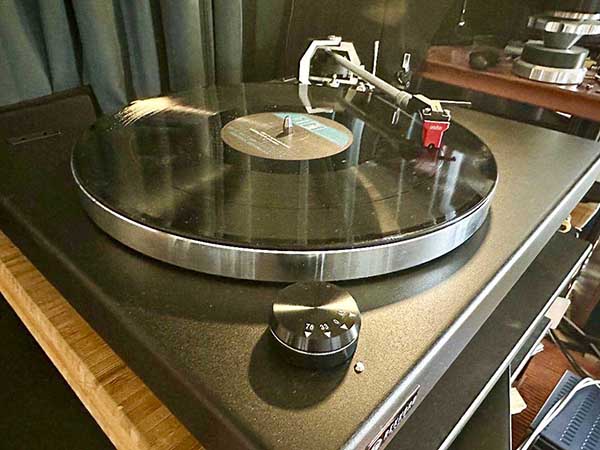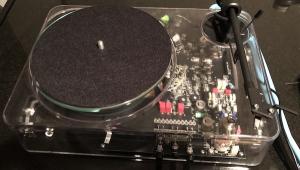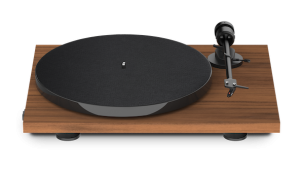Is the Rekkord M600 Turntable a Modern Marvel of German Craftsmanship?

Drawing inspiration from the legendary MPS Records, a 1970s German powerhouse that produced memorable records by Oscar Peterson, Joe Pass, and countless others, Rekkord Audio carries the torch of meticulous German craftsmanship. Nestled in the heart of the Black Forest, each Rekkord turntable, we’re told, is “meticulously” assembled by local artisans, ensuring a level of quality and heritage worthy of the music it plays.
Rekkord is owned by Heinz Lichtenegger, the affable CEO of Pro-Ject Audio Systems. Like the products from Pro-Ject, Rekkord is all about quality. “The know-how behind our products looks back on almost a century of tradition, which was founded here in St. Georgen and has played a role in the world market,” states the company’s official site. “Every part, every screw, and every spring is assembled and carefully adjusted in many small steps in order to achieve the best sound quality.” Hmmm, a turntable company with practically a 100-year history, yet virtually unknown in the U.S.? Let’s rectify that.

Rekkord specializes in user-friendly, automatic belt-drive turntables — perfect for vinyl newbies in the U.S. market. But don’t mistake user-friendly for under-engineered. A staggering 99% of Rekkord’s turntable components are crafted right in their Black Forest factory, or sourced from nearby partners. This meticulous, vertically integrated approach allows them to churn out a whopping 30,000 to 40,000 turntables a year, essentially exclusively for the European market — until now! Rekkord’s dedication to quality and their impressive production output speak volumes about their professionalism and popularity abroad.
Let’s look at the product line. Reportedly located in the same factory that made Dual turntables, Rekkord makes four “fully automatic turntables,” two of which are considered entry level — the F100 ($369) and F110 ($449) — plus the “advanced fully automatic turntable” dubbed the F300 ($599), and the “fully automatic audiophile table” known as the F400 ($799-$949). All four of these automatic tables share a similar look and component complement.
Meanwhile, the fully manual M500 audiophile table ($1,199-$1,299) has a sleek, slightly retro look, and it features a “technically high-quality Rekkord tonearm, which combines a heavy basic chassis with a floating sub-chassis in a modern design.”
And then there’s Rekkord’s top-of-the-line turntable, the M600, which we first reported here on AP back on March 4. This table is described on the company site as a “high-end manual subchassis turntable.” The M600 is available in two finishes, matte-black ($1,499) and gloss-black ($1,699). The matte-black version of the Rekkord M600 is the subject of our review here today, so let’s get to it.

Specs & Features
The Rekkord M600 boasts a vibration-resistant plinth crafted from a wooden chassis. This substantial base is cloaked in a high-quality piano lacquer, meticulously polished in a six-step process. The elegant form is further complemented by an 8.6in aluminum tonearm. This precision instrument pivots on a sophisticated 4-way ball-cardan bearing housed within sleek, solid aluminum blocks that recalls the Brutalist look of Tron. Completing the picture is what appears to be an aluminum tonearm wand and a torsion-resistant carbon headshell.
The table’s aluminum platter is fitted with an internal “dampening pouring compound” to minimize resonances. In Rekkord’s words, “This also increases the mass and thus ensures the most accurate and stable speeds” and “helps dampen all resonances and minimize wow and flutter.”
The M600 offers 33, 45, and 78rpm playback speeds via an “electronic regulated DC motor. With electronic switching, you can effortlessly change the speed of the M600.” The table stands 17 x 5½ x 14.5in (440 x 135 x 370mm) (w/h/d), weighs 18lb (8.3kg), and has a wow and flutter measurement of 0.05% (a rarely sighted spec these days). The M600 comes fitted with the Ortofon Quintet Red MC cartridge ($399). Interconnects, dustcover, and a singles adapter are also included, as is a basic felt mat.

Is the Rekkord M600 the Rega Planar 3 slayer? Priced competitively, the Rekkord certainly seems poised to challenge the Rega’s dominance. Equally equipped, Rekkord isn’t just a turntable manufacturer — they’re a one-stop shop for vinyl enthusiasts by also offering cleaning machines, brushes, and even their own cleaning fluid.
To be clear, the M600 looks and feels nothing like a Rega machine. Unlike the sleek minimalism of Rega turntables, the M600 boasts a robust, German-inspired design. It exudes solidity with a well-built, smartly designed plinth, but trades Rega’s elegance for a chunkier look. Some may prefer the slender streamlined plinth of the Planar 3, as the M600 is comparatively thicker and more substantial.

The Rega tonearm has been refined and perfected over many years. It’s a solid piece of aerodynamic, time-tested machinery. The M600’s tonearm might surprise you — as it did me — with its lighter style compared to that of the Rega. However, it features novel VTF and anti-skate adjustments that surpass most entry-level turntables — if they function as well as advertised, that is.
Tonearms on Rekkord tables are raised or lowered via an adjustable screw sited at the back of the plinth. Rega tables, meanwhile, do not allow for fine tonearm height adjustment — a critical leveling parameter if you believe VTA, or vertical tracking angle, is essential in getting the best sound from your records. (Rega does offer a spacer, however.)

Setup
My Rekkord M600 review sample arrived with a “pre-adjusted” Ortofon Quintet Red cart. Alignment checked by using my Feickert Universal Protractor was off by an mm or two. The counterweight slid easily over the butt of the tonearm. Once the cart was zeroed, tracking force was attained by using a small vertical dial that reportedly sets the cart’s suggested tracking force. Rekkord refers to this process as “massless tracking force.”
Anti-skate gets its own dial as well, sunken into the table near the cardan bearing block, which also has that Brutalist aesthetic currently making a comeback. Rekkord again: “The massless tracking force adjustment optimizes the center of gravity directly in the bearing center.”
In practice, I didn’t find the M600’s VTF or pre-alignment practices to be fully up to snuff. While I did like the feel of the counterweight in my fingers, using the VTF dial to set tracking force failed. It was a gram off, according to my Riverstone Audio Precision Stylus Tracking Force Pressure Gauge. And, as noted previously, the pre-aligned Ortofon cart was off by a couple millimeters. (Perhaps it takes a bit of practice to achieve satisfaction with the Rekkord table’s onboard tools.)
My review system included an Aurorasound VIDA MkII phono preamp (which is in for an upcoming AP review), PrimaLuna EVO 300 hybrid integrated amp, Volti Audio Razz loudspeakers, AudioQuest Robin Hood ZERO speaker cables, and Triode Wire Labs Spirit II interconnects.

Listening Sessions
Regardless of what I noted above about the pre-alignment, I was very impressed with the Rekkord M600’s sound. Practically out of the box and accurately dialed in, the M600 presented music with energy, drive, focused imaging, and decent bass lucidity. The M600 pulled every bit of information out of recordings in dramatic fashion, and was never threadbare or lacking in body. While absolute weight of electric and acoustic bass instruments was nothing special, bass was very clean, well-imaged, and with satisfactory texture.
The M600 consistently impressed with its expansive and meticulously delineated soundstage. Instrumental and vocal timbres were rendered with precision, occupying distinct spatial positions within the sonic panorama. The layering and separation of these sonic images were impressive, creating a sense of depth and dimensionality. The M600 eschews aural fatigue; its presentation is neither languid nor anemic, nor veiled or lacking in vibrancy. It boasts an abundance of dynamic energy, conveying the physicality inherent to the recording.

The M600/Ortofon combo occasionally leaned toward a touch of forwardness in the upper-midrange, particularly noticeable on certain horn blasts or percussive attacks. However, this emphasis often complemented the music’s natural energy, fostering a sense of immediacy. Despite this occasional brightness, the Rekkord M600 table paired with the Ortofon cart capably tackled the intricacies of jazz, the pulsating rhythms of electronic music, and the nuanced dynamics of classical pieces. The sound is undeniably impactful, delivering both rhythmic drive and moments of serene immersion.
I started with a bonfire — Art Blakey & The Jazz Messengers’ 1963 LP Buhaina’s Delight (Blue Note, deep-groove, New York, P-Pressing, BLP 4104). On inexpensive turntables, Jazz Messengers Blue Note records can sound, well, a bit sleepy, their dynamic ensemble heroics condensed into a sloppy soup. Not so with this machine. Blakey’s famous buzz rolls had power and precision, Freddie Hubbard’s trumpet had splat! and emotive smoke, and Wayne Shorter’s tenor sax blew with ferocity and scorching flames. Layering of this legendary band via the Rekkord M600 was precise and well-separated. There was even enough punch and power to resurrect Rudy Van Gelder. The Jazz Messengers were all about freedom, finery, excellence, and aggro rhythms — and all of it was expressed beautifully by the M600.
Though the M600 isn’t the last word in bass weight or extension, you wouldn’t know it by spinning Kems Kriol’s 2021 EP Equanimity (Nous’klaer Audio, Netherlands). The kind of woozy, head-spinning, electronic music that’s made more for the mind than body (no house thump-thump here) spun out of the speakers with dizzy engagement, its exotic ingredients of Arabic female chant, Indian tabla rhythms, scalding synth tones, and cottony beats like a balm, as if covering me in lace and linen. This was fat, bass-centric music, surrounding me in a cloud of womb-like, shape-shifting images that pulsed though my limbs and vibrated the floor.

Playing the Rhino High Fidelity Series 2024 reissue of John Coltrane’s 1961 LP Olé Coltrane (Atlantic FHF1 1373/081227817374) and its Side 2 opener, “Dahomey Dance,” the M600/Ortofon combo continued to impress. Its ability to extract tons of energy and detail from a record, coupled to its taut physicality and tight bass representation made for a perfect jazz fit. Though Trane’s horn was a mite forward-sounding and Elvin Jones’ drums not quite fully dimensional, the M600’s dependable detail retrieval, consistent transparency, and well-organized soundstage made for an outstanding Coltrane performance. Rather than over-focusing on the table, I was caught up in the music. I marveled at the beautifully layered instruments within a broad stage, and that only allowed deeper immersion into the music.
Finally, I played a new LP, guitarist Anthony Wilson’s 2023 release Collodion (Colorfield). Mastered by Kevin Gray at Cohearent Audio, this music is far from jazz standards and stock guitar solos. This is a sound tapestry in service to electronic assignations, far closer to Kem Kriol’s above-noted Equanimity than Grant Green’s Idle Moments.
Atmospheric and pliant, Wilson’s music recalls the cloud formations of the ECM label — or, if taken to the extreme, the rolling electronic structures of Alex Paterson and his ambient/electronic collective, The Orb. Sounds flow in and out of a central core, tones pulse and whirr, and frosty keyboards swell and glow. It’s fuzzy music, but specific and expressive, with the Rekkord M600 wresting drive, energy, clarity, and low-end throbs from the grooves.

Conclusions
Though I didn’t have a Rega Planar 3 on hand to directly compare to it in the moment, I didn’t need one to know that the Rekkord M600 turntable is a utilitarian-looking, fantastic-performing analog machine. It played with excellent solidity, and created clean images in a large, layered soundstage. Music had liquidity and drama, life force and flow. The Rekkord M600’s excellent detail retrieval never sounded thin or etched. It was a top-to-bottom capable performer, from its mostly delicate treble to clear mids and tight, if not exceptionally deep, bass. Playing music was fun, fulfilling, and satisfying. In short, the Rekkord M600 was an absolute joy. Given its affordable, nicely under $2K SRP, the Rekkord M600 consistently delivers the kind of performance worthy of your attention.
For more about Rekkord, go here.
To find an authorized Rekkord dealer, go here.





















































